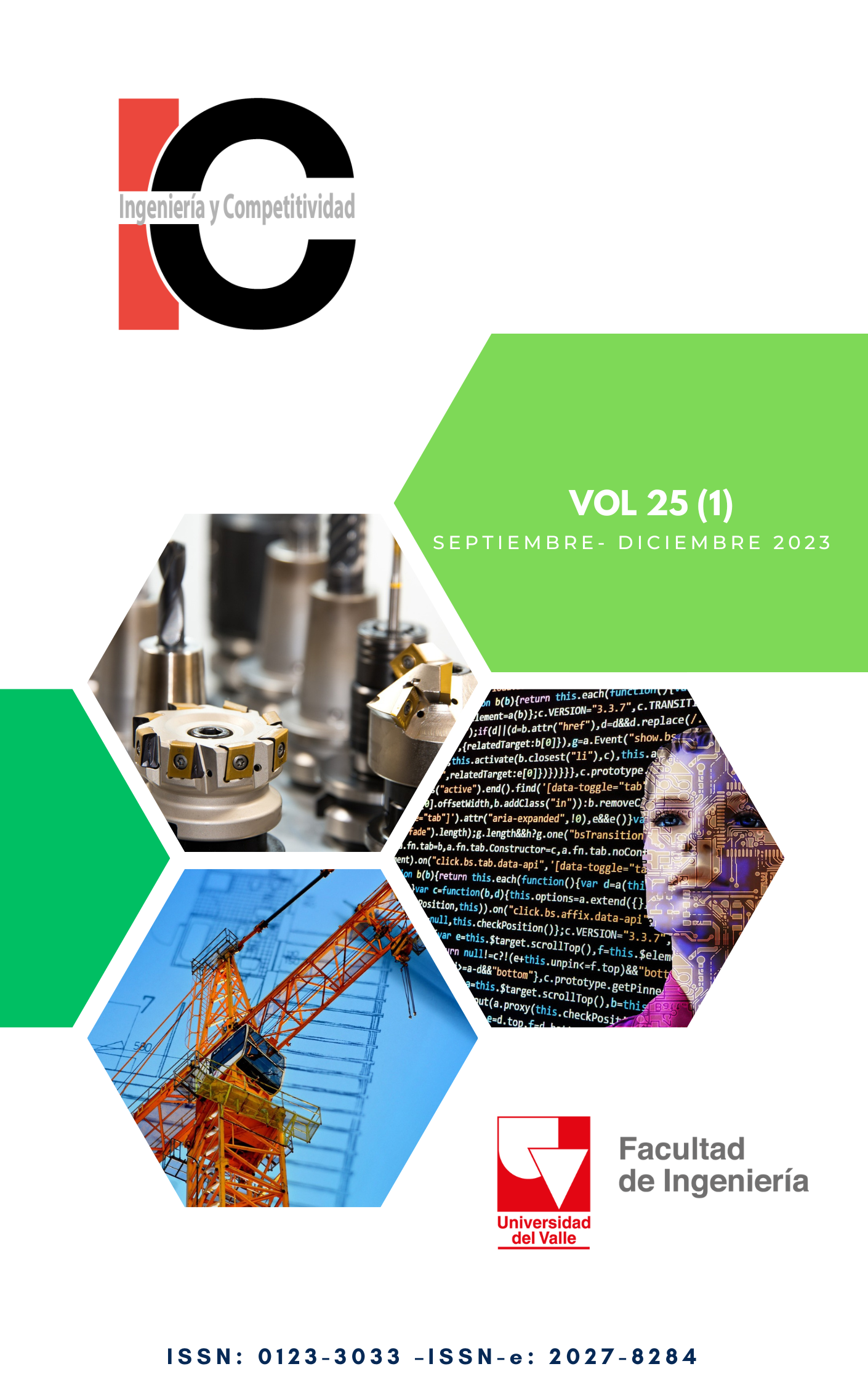Determinación de los coeficientes biocinéticos de un sistema aerobio para remoción de almidón de papa
Palabras clave:
Biotecnología, Bioremediación, Remoción de almidón, Tratamiento de aguaContenido principal del artículo
Este estudio presenta el rendimiento de un reactor aerobio completamente mezclado, a escala de laboratorio, para el tratamiento de aguas residuales provenientes de la extracción de almidón de papa. El reactor se operó durante 119 días divididos en 5 fases de operación que incluyeron la puesta en marcha y la variación del tiempo de retención celular. Con el fin de determinar los coeficientes biocinéticos, el tiempo de retención celular se varió entre 20 y 4 días, y el funcionamiento del sistema se estableció con tiempo de retención hidráulica de 24 horas a una configuración hidráulica de mezcla completa. La concentración de demanda química de oxígeno fue de 1000 mg/ en la entrada del reactor y el oxígeno disuelto permaneció por encima de 2 mg/L.
En este tiempo de experimentación se monitorearon parámetros como pH, demanda química de oxígeno (en el afluente y efluente), oxígeno disuelto y sólidos suspendidos del licor de mezcla. El cálculo de las constantes biocinéticas se realizó mediante un método aproximado, utilizando el método gráfico Lineweaver-Burk. Los coeficientes biocinéticos determinados fueron: La tasa máxima de remoción de sustrato , la tasa media de saturación o constante de afinidad ( , el coeficiente de rendimiento de lodo (Y) y la tasa de respiración endógena .
Los resultados mostraron que Y, , y ( estuvieron en un rango de 0,3- 0,7 mgSSV/mgBOD5, 2- 8 1/día y 40-120 mg/L (COD- BOD5), respectivamente. Estos valores de los coeficientes estuvieron en el rango de los coeficientes reportados en la literatura en el tratamiento convencional de lodos activados empleados para el tratamiento de residual doméstica.
Ain, N., & Awang, N. A. (2021). Civil and environmental engineering reports the relationship between the biokinetic parameters of an aerobic granular sludge system and the applied operating conditions. Civil and Environmental Engineering Reports, 31, 0161–0171. https://doi.org/10.2478/ceer-2021-0011
Al-Malack, M. H. (2006). Determination of biokinetic coefficients of an immersed membrane bioreactor. Journal of Membrane Science, 271(1–2), 47–58. https://doi.org/10.1016/j.memsci.2005.07.008
Antwi, P., Li, J., Boadi, P. O., Meng, J., Shi, E., Deng, K., & Bondinuba, F. K. (2017). Estimation of biogas and methane yields in an UASB treating potato starch processing wastewater with backpropagation artificial neural network. Bioresource Technology, 228, 106–115. https://doi.org/10.1016/j.biortech.2016.12.045
APHA. (2017). STANDARD METHODS. For the examination of water and wastewater (E. W. Rice, R. B. Baird, A. D. Eaton, & L. S. Clesceri (eds.); 23 nd). American Public Health Association, American Water Works Association, Water Environment Federation.
Cai, T., Lin, H., Liu, Z., Chen, K., Lin, Y., Xi, Y., & Chhuond, K. (2019). IOP Conference Series: Earth and Environmental Science Starch wastewater treatment technology. IOP Conf. Ser.: Earth Environ. Sci, 358, 22054. https://doi.org/10.1088/1755-1315/358/2/022054
Inc, M. & E., Tchobanoglous, G., David, S. H., Ryujiro, T., & Burton, L. F. (2014). Wastewater enginneering treatment and resource recovery. McGraw Hill.
Khlifa Alfeluo, J., Aljfairi, K. S., & Hawege, E. F. (2021). العلوم :األسمرية الجامعة مجلة والتطبيقية األساسية ا ( لمجلد 6 العدد ) 2 (يونيو 2021 )م :ص ص 91-100 Biokinetic Coefficients Determination for the Biological Treatment of Langat River. Journal of Alasmarya University: Basic and Applied Sciences, 6(2), 91–100.
Moghaddam, A. H., & Sargolzaei, J. (2012). A mini-review over diverse methods used in starchy wastewater treatment. Recent Patents on Chemical Engineering, 5(2), 95–102. https://doi.org/10.2174/2211334711205020095
Molina, J. F., Rodriguez, C., & Bolívar, E. B. (2008). Manual de laboratorio procesos biologicos.
Molina Perez, F. J. (2011). Procesos Biológicos (Pimera edi). Reimpresos, Universidad de Antiquia.
Monod, J. (1949). The growth of bacterial cultures. Ann. Rev. Microbiol, 3, 371–394.
Mousavian, S., Seyedsalehi, · M, Paladino, · O, Sharifi, · P, Kyzas, · G Z, Dionisi, · D, & Takdastan, · A. (2019). Determining biokinetic coefficients for the upflow anaerobic sludge blanket reactor treating sugarcane wastewater in hot climate conditions. International Journal of Environmental Science and Technology, 16(3), 2231–2238. https://doi.org/10.1007/s13762-017-1631-5
Orozco Jaramillo, A. (2014). Bioingenieria de aguas residuales. Teoria y diseño (Segunda). Acodal.
Romero Rojas, J. A. (2000). Tratamiento de aguas residuales. Teoria y principios de diseño. (1ra ed.). Editorial Escuela Colombiana de Ingenieria.
Sperling, M. Von, & Chernicharo De Lemos, C. A. (2005). Biological Wastewater Treatment in Warm Climate Regions - Volume Two. 634. https://doi.org/10.5860/CHOICE.45-2633
Sponza, D. T., & Uluköy, A. (2008). Kinetic of carbonaceous substrate in an upflow anaerobic sludge sludge blanket (UASB) reactor treating 2,4 dichlorophenol (2,4 DCP). Journal of Environmental Management, 86(1), 121–131. https://doi.org/10.1016/j.jenvman.2006.11.030
Wang, R. M., Wang, Y., Ma, G. P., He, Y. F., & Zhao, Y. Q. (2009). Efficiency of porous burnt-coke carrier on treatment of potato starch wastewater with an anaerobic-aerobic bioreactor. Chemical Engineering Journal, 148(1), 35–40. https://doi.org/10.1016/j.cej.2008.07.028
Downloads

Esta obra está bajo una licencia internacional Creative Commons Atribución-NoComercial-CompartirIgual 4.0.
Los autores que publican en esta revista están de acuerdo con los siguientes términos:
Los autores ceden los derechos patrimoniales a la revista y a la Universidad del Valle sobre los manuscritos aceptados, pero podrán hacer los reusos que consideren pertinentes por motivos profesionales, educativos, académicos o científicos, de acuerdo con los términos de la licencia que otorga la revista a todos sus artículos.
Los artículos serán publicados bajo la licencia Creative Commons 4.0 BY-NC-SA (de atribución, no comercial, sin obras derivadas).

